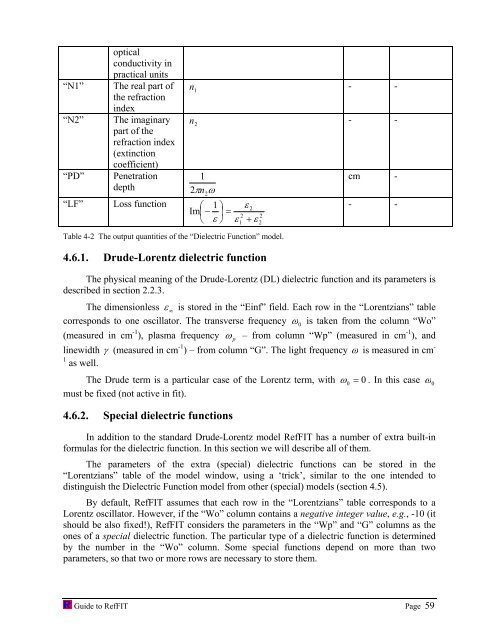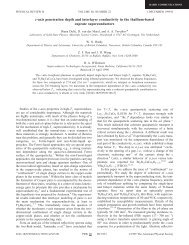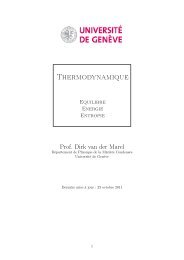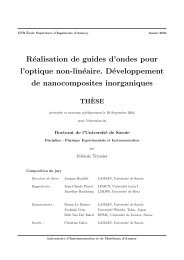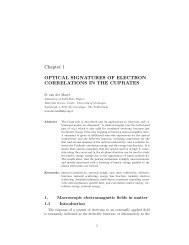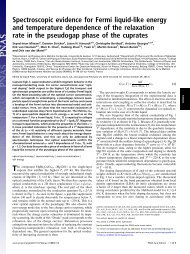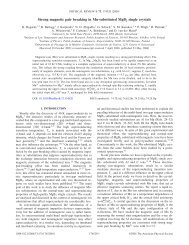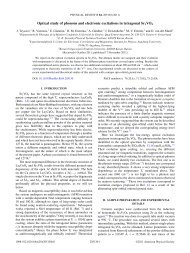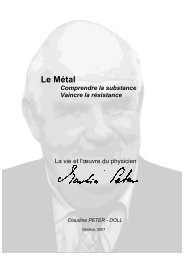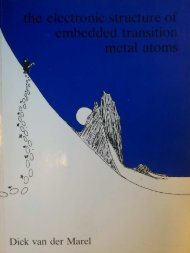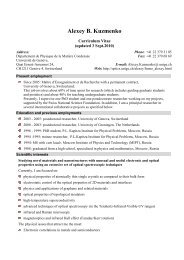software to fit optical spectra - Quantum Materials Group
software to fit optical spectra - Quantum Materials Group
software to fit optical spectra - Quantum Materials Group
You also want an ePaper? Increase the reach of your titles
YUMPU automatically turns print PDFs into web optimized ePapers that Google loves.
<strong>optical</strong><br />
conductivity in<br />
practical units<br />
“N1” The real part of<br />
the refraction<br />
index<br />
“N2” The imaginary<br />
part of the<br />
refraction index<br />
(extinction<br />
coefficient)<br />
“PD” Penetration<br />
depth<br />
1<br />
2πn2ω<br />
“LF” Loss function ⎛ 1 ⎞ ε 2<br />
Im⎜−<br />
⎟ = 2 2<br />
⎝ ε ⎠ ε + ε<br />
Table 4-2 The output quantities of the “Dielectric Function” model.<br />
4.6.1. Drude-Lorentz dielectric function<br />
n - -<br />
1<br />
n - -<br />
2<br />
1<br />
cm -<br />
Guide <strong>to</strong> RefFIT Page 59<br />
2<br />
- -<br />
The physical meaning of the Drude-Lorentz (DL) dielectric function and its parameters is<br />
described in section 2.2.3.<br />
The dimensionless ε ∞ is s<strong>to</strong>red in the “Einf” field. Each row in the “Lorentzians” table<br />
corresponds <strong>to</strong> one oscilla<strong>to</strong>r. The transverse frequency ω 0 is taken from the column “Wo”<br />
(measured in cm -1 ), plasma frequency ω p – from column “Wp” (measured in cm -1 ), and<br />
linewidth γ (measured in cm -1 ) – from column “G”. The light frequency ω is measured in cm -<br />
1<br />
as well.<br />
The Drude term is a particular case of the Lorentz term, with ω 0 = 0 . In this case ω 0<br />
must be fixed (not active in <strong>fit</strong>).<br />
4.6.2. Special dielectric functions<br />
In addition <strong>to</strong> the standard Drude-Lorentz model RefFIT has a number of extra built-in<br />
formulas for the dielectric function. In this section we will describe all of them.<br />
The parameters of the extra (special) dielectric functions can be s<strong>to</strong>red in the<br />
“Lorentzians” table of the model window, using a ‘trick’, similar <strong>to</strong> the one intended <strong>to</strong><br />
distinguish the Dielectric Function model from other (special) models (section 4.5).<br />
By default, RefFIT assumes that each row in the “Lorentzians” table corresponds <strong>to</strong> a<br />
Lorentz oscilla<strong>to</strong>r. However, if the “Wo” column contains a negative integer value, e.g., -10 (it<br />
should be also fixed!), RefFIT considers the parameters in the “Wp” and “G” columns as the<br />
ones of a special dielectric function. The particular type of a dielectric function is determined<br />
by the number in the “Wo” column. Some special functions depend on more than two<br />
parameters, so that two or more rows are necessary <strong>to</strong> s<strong>to</strong>re them.


